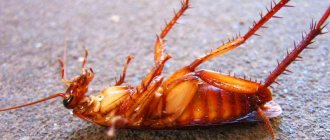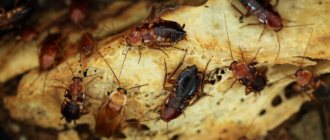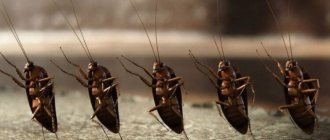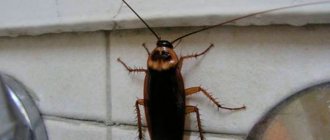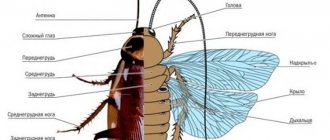Troop Lice
Represented exclusively by external parasites of mammals. The sucking mouthparts of lice are structured in a unique way, unlike, for example, the sucking mouthparts of bedbugs (Fig. 17).
Rice. 17. Squad Lice
The transformation of lice is incomplete. They don't have wings.
Lice should never be confused with fleas, which is often done due to their similar parasitic lifestyle. In fleas, the transformation is complete - these are completely different insects (Fig. 18).
Rice. 18. Louse and flea
Like other bloodsuckers, lice must somehow prevent blood from clotting in their digestive system.
To do this, substances that prevent blood clotting - anticoagulants - are released into the wound along with saliva.
The limbs of lice are tenacious, strong, and claw-shaped. With their help, they are attached to hair or clothing fibers.
About 250 species of these insects are known. Their body length ranges from 0.4 to 6 mm. Female lice lay eggs on hair or clothing. These eggs are called nits (Fig. 19). In total, a female can lay up to 300 eggs during her life.
Rice. 19. Nits
Lice are carriers of pathogens of various diseases. The most dangerous among them are chain fever and relapsing fever. The habitat of lice is hair-covered areas of the body and human clothing. Prevention of lice means keeping your body and clothes clean. The main measure to eliminate lice is the use of special products that are sold in pharmacies.
The most interesting facts about cockroaches
In the modern world, there are approximately 4,000 species of cockroaches, but only 30 of them are able to live near people, that is, in our homes. They are average in size by insect standards, yet they display amazing powers of endurance and survival. Moreover, cockroaches are able to exist even after several desperate attempts by humans to get rid of unwanted “neighbors.” What allows them to survive in the most difficult environmental conditions?
There are about 4,000 species of cockroaches in the world
Let's look at some facts about cockroaches:
- A cockroach can easily live for a whole week without a head. After the insect's body is deprived of its head, all systems function normally, the insect lives for a long time and could have continued to live, but death occurs. Why? The fact is that without a head, it is not able to receive food and water, so it dies from dehydration and lack of nutrients.
- The cockroach has two pairs of wings. The first of them is the elytra, which have a dense leathery structure; with them the cockroach covers the body for protection. We see them if we look at the insect from above. But the flight is ensured by another pair of wings; it folds under the first pair, that is, under the elytra.
- A cockroach can not breathe for 40 minutes. This is one of the qualities that allowed these creatures to survive on Earth. Throughout the existence of these insects, shifts and significant changes in climate have repeatedly occurred on our planet, but due to their abilities, cockroaches were able to survive. Research shows that these insects appeared more than 280 million years ago, which is truly surprising.
- A cockroach spends 75% of its life in standby mode. We are accustomed to the fact that these insects actively run around the kitchen or bathroom, however, they spend three quarters of their lives in a calm state. It should be noted that these are one of the laziest organisms in nature.
- The cockroach can reach high speeds of movement. If the insect nevertheless leaves its shelter, as a rule, in search of food or water, then it is capable of developing high speed, especially in conditions of danger. Studies have shown that it is capable of reaching a speed of 4.8 km/h. If a cockroach were the same size as a cheetah, it could run 80 km/h, which is not all that different from the fastest animal on Earth. The speed of the cockroach is quite impressive.
- Cockroaches eat any food. These insects have powerful mouth jaws, so they are able to sweep away everything in their path. An interesting fact is that a cockroach only needs to eat once a month to survive, even in negative conditions.
- Fast nervous system. Ever tried to catch a cockroach? It is very difficult to do this, since his reactions and reflexes are well developed; they are calculated in fractions of a second. There are tiny hairs on the legs of insects; they are able to detect even the slightest vibrations in the air, so the cockroach always senses the approach of an animal or a person. Thanks to a combination with a fast nervous system, individuals are able to change their direction 25 times per second, which only high-speed cameras could record.
- They will survive an atomic explosion. On its way, the blast wave destroys all living organisms, but scorpions and cockroaches are not susceptible to such effects, that is, they are able to survive from an atomic explosion. If we delve more scientifically into this topic, we can find out that in these insects the process of cell division is slowed down, so the effect of radiation is not so destructive.
- The fertility of cockroaches is surprising. It should be noted that cockroaches reproduce intensively and in large numbers. For example, on average one cockroach lives 6 months. For one litter, a female is able to bear approximately 30-40 eggs in her sac, it is called an ootheca; throughout their life they bear about 8 such sacs, this is equal to 320 cubs. Even if only 10 cockroaches are females, after a couple of months thousands of new individuals will appear, which is why it is so difficult to cope with them.
- The largest cockroach. Sometimes it seems that an impressively sized cockroach has run through the kitchen, but compared to the largest cockroach, these are just babies. The size of cockroaches can reach 10 centimeters, but they live in the tropics, and live at home only as an exotic pet. Scientists believe that in the past, even before the advent of dinosaurs, cockroaches reached a length of about 50 centimeters.
These are the main factors about cockroaches that are truly impressive and surprising. They are what allow these insects to survive in the most negative environmental conditions.
general information
The structure of all beetles, of course, varies, but in general terms it can always be described. Most beetles have a separate head, which most likely contains antennae, eyes and mouthparts. Behind the head is the next part of the body - the chest. It is less mobile relative to the head. The first and second pairs of legs are located on the chest. The last body segment is the abdomen. The last pair of legs is located on it, the ducts of excretory glands and secretions open, with the help of which the beetle can mark the territory or leave a trace for communication with relatives, as well as spiracles.
Both wings are hidden under hard elytra
The entire body of the beetle is covered with a hard chitinous covering, which acts as an exoskeleton. This cover also protects the insides of the beetle from mechanical damage. The hard elytra are also made from the same material, which cover the beetle’s wings in a state of rest and protect them from damage.
General structure of the body of insects (with diagram and pictures)
The body of insects consists of segments - segments that vary in shape and bear various external appendages and organs. The body structure of insects includes three sections: head, thorax and abdomen. The head contains the main sensory organs and the oral apparatus. Insects have on their heads a pair of elongated segmented antennae (antennae) - organs of touch and smell - and a pair of complex compound eyes - the main visual organs. In addition, many insects have from 1 to 3 small simple ocelli - auxiliary light-sensitive organs. The oral apparatus of insects is formed on the basis of 3 pairs of jaws - modified limbs of the head segments, the third pair of jaws is fused. The chest consists of 3 large segments: prothorax, mesothorax, metathorax - and carries locomotor organs. Each segment contains one pair of jointed legs: front, middle, hind. Most insects have two pairs of wings: the anterior ones, located on the mesothorax, and the posterior ones, located on the metathorax. In a number of insects, one or both pairs of wings may be underdeveloped or even completely lost. The abdomen, consisting of numerous uniform segments, contains most of the internal organs.
Pay attention to the picture - in the structure of the abdomen of insects there are 11 segments, but most insects retain from 5 to 10 segments:
In the 8-9th segments, according to their full composition, the reproductive apparatus is located. V females of some insects (Orthoptera, Hymenoptera) have a special organ for laying eggs, the ovipositor, developed on the underside of these segments. Some insects (mayflies, cockroaches, orthoptera, earwigs) have a pair of cerci on the last segment of the abdomen - appendages of various shapes and purposes.
Look at the detailed diagram of the structure of insects, where all the main sections are indicated:
What kind of mouthparts do cockroaches have?
The device for grinding food includes a modified upper and lower lip, a pair of upper and lower strong jaws with palps.
Before anything edible enters the insect's digestive tract, it is tested for suitability using 2 pairs of olfactory palps attached to the branches of the lower jaw and lip.
The nutrient substrate is clamped between the protruding lips of the insect from above and below, falling into the hollow. For reliable fixation of a piece of food there is a pair of sickle-shaped lower jaws.
Chewing a bolus of food is carried out with the help of maxillae - the upper jaws, which have several sawtooth serrations that serve as teeth. In parallel with grinding in the oral cavity, the edible lump is moistened with saliva, rich in digestive juices.
The oral apparatus, adapted to breaking down coarse food particles with strong chewing organs, is called gnawing. This is exactly the type of mouthparts of a cockroach. It opens up the opportunity for the mustachioed to include in its diet almost everything that comes along the insect’s path.
Interesting! The insect's jaws are covered with a dense substance - chitin, which gives the insect's mouthparts greater strength. The complex structure is driven by the masticatory muscles.
Appearance
Now we should say a few words about what black cockroaches look like . This information will definitely be of interest to people interested in entomology. However, ordinary people who have not previously encountered these parasites will also be interested in learning a little more about them.
Black cockroaches are larger than their red counterparts. Females usually reach larger sizes than males. Typically, the length of such insects can be three centimeters, but this is not the limit. You can stumble upon individuals reaching five centimeters in length.
As you can guess from the name of this type of cockroach, the chitinous shell of these insects is black in color; insects of a brown hue are less common. The cover of cockroaches has some shine and is very durable, so it is not easy to crush the parasite. It should be noted that due to the fact that the parasite is flat, it has the ability to penetrate into the narrowest crevices.
How many days do cockroaches live without food and water?
Cockroaches can go for a very long time without food. Harmful insects have a distinctive feature - low sensitivity of hunger receptors. Cockroaches can live for a long time without food also due to:
- Slow metabolism;
- Low energy consumption for the processes of thermoregulation, oxidation and respiration.
Red cockroaches can live without food for 40 to 45 days, and black pests - up to 75 days.
It is not surprising that cockroaches are very often found in apartments and houses, because there are all the conditions for their comfortable existence: warmth, water and a large amount of varied food. In addition to its speed and
endurance, cockroaches are known for their appetite. They easily adapt to different conditions and changes, and in the absence of food they can survive by eating various synthetic materials.
Experiment what cockroaches like more:
Internal structure of a cockroach
You've probably heard that cockroaches can live without a head for a whole week, or even a month. But you hardly know what physiological characteristics make this possible. Below I will talk about how these amazing insects work from the inside, and why cockroaches feel great even after they have been decapitated.
Digestive system
We already know how the jaws of the black and red cockroach are structured, but what happens to the food next? As I said, the mouth contains salivary glands that secrete saliva to soften and moisten food before swallowing. It is noteworthy that what is eaten will be partially digested in the insect’s crop, and the stomach will do the rest.
Thanks to its muscular structure, it seems to “grind” food, sending it then to the midgut, then to the hindgut and to the excretory system. The intestines of cockroaches are populated by bacteria and fungi, thanks to which the insect is able to digest even inorganic compounds.
Interestingly, the cockroach does not need to chew its food too thoroughly - in the part of the foregut located immediately behind the mouth, there is a row of teeth that will certainly thoroughly crush what it swallows in a hurry. Cockroaches do not have a urethra, so both feces and urine are excreted through the anus.
Circulatory system
The circulatory system of cockroaches is of the open type, and the blood of these creatures is white and is called “hemolymph”. Blood circulates freely inside the body, washing all internal organs. The movement of hemolymph is due to the work of the heart, and the speed of blood circulation is very slow, making the cockroach very sensitive to environmental temperature.
Respiratory system
The cockroach breathes using spiracles - these are 10 pairs of small holes that are located on the sides of the abdomen. The spiracles continue with tracheoles - tubes that form a system and connect into six large tracheal trunks. This structure of the respiratory system allows oxygen to be diffusely supplied to all internal organs.
Reading on the topic: How to get rid of cockroaches in a private home - protection for always
As you can see, the brain is in no way responsible for the respiratory activity of a cockroach, and there is no pressure in the circulatory system, and it is for these reasons that the creature is able to live without a head. A healthy individual, even if decapitated, can survive without a head for up to a month, since in a static state the insect does not waste energy and therefore does not need food.
Nervous system
11 nerve ganglia, the so-called “ganglia”, form the nervous system of cockroaches. The two largest nodes located in the head are a kind of brain. These two nodes are responsible for vision and antennae.
The thoracic ganglia (there are 3 in total) innervate the wings, mouthparts, thoracic muscles, and paws. Another 6 small nodes are located in the abdomen, and they end with a large terminal node, which is responsible for the functioning of the genital organs and the hearing organs. Don't be surprised, because the cockroach's auditory receptors are located near its anus. 11 nodes continue with an extensive network of nerve fibers designed to provide innervation to all organs, including the sensory organs.
Diet
Prussians are unpretentious about the nutritional value and taste of food: they are able to eat and process any organic substrate.
What do cockroaches eat in an apartment? Their daily menu successfully includes the following products:
- bakery;
- pasta, confectionery;
- vegetables fruits;
- meat and sausages, cheese;
- seasonings;
- jam, sweet drinks;
- human-prepared dishes, leftover food, crumbs.
The main requirement for food is its availability, so their diet often consists of expired food debris that has fallen on the floor and then remains after poor-quality cleaning of the premises and has been affected by mold fungi.
Aroma enhancers and sugar speed up the discovery of food using the olfactory receptors of cockroaches, shaping their taste preferences. In the absence of access to human food, insects do not disdain:
- newspaper, book glue, paper;
- clothing fabric or book bindings;
- leather goods;
- paste with starch;
- wallpaper.
As we can see, the variety of types of food cockroaches have is very wide.
Interesting! The male is able to eat about 25 grams of food per day, the female – up to 50.
Damage caused by cockroaches
Huge black cockroaches most often come into people's apartments from the worst places - garbage cans, sewers, they drag pathogenic microorganisms and helminth eggs on their paws, litter the room with the products of their vital activity - excrement, chitinous coverings left after molting.
They not only spoil the appearance of the home, but can also cause serious harm to human health, as they provoke allergic reactions, including pronounced ones.
How does food search happen?
Since cockroaches are very shy pests, the process of searching for food occurs at night. A small group of pests crawls out of the shelter for reconnaissance.
After the scouting team finds a place with food, it immediately returns to the nest. The insects mark their return route with special secretions.
IMPORTANT: A female cockroach needs 40 grams of food per day, and a male needs half as much.
Insects cause the greatest harm by biting food. After this, food should not be eaten, because insects are carriers of bacteria, allergy agents, worms, and infectious diseases.
How to get rid of cockroaches forever?
After you manage to expel cockroaches from your home, you should make sure that the insects do not return to you. To do this, it is enough to follow a few rules.
- Always store pans, pots and deep bowls upside down, as deep dishes that are stored in a dark place are an ideal place for cockroaches to lay eggs.
- Don't clutter your home. Cockroaches can settle literally in any place that is comfortable for them: in a pile of paper, in things that are rarely worn, in forgotten food, and so on. Therefore, keep clean not only in the house, but also in the attic, and even in the garage.
- Cockroaches do not tolerate the smell of mothballs, so feel free to place mothballs around your apartment so that the insects do not want to crawl to visit you.
- If you have doubts about some holes in the floor or on the wall, simply plug them with an ordinary plastic bag, limiting cockroaches' access to your home.
- Place orange and lemon peels, dried cloves, fresh mint leaves, cucumber peels and cut garlic cloves near the baseboards and doors - cockroaches hate the smell of these products.
- For the first time after baiting cockroaches, leave the lights on in the kitchen or lighting on the cabinets, since insects prefer to sit in the dark.
- Dead cockroaches should either be flushed down the toilet or disposed of in any other reliable way. Under no circumstances should you leave corpses in the apartment, since cockroaches are cannibals, and the remains of their relatives can become excellent food for them.
- After visiting hotels, boarding houses and other temporary accommodation institutions, carefully check your clothes and bags, because one cockroach accidentally brought into the house can lay eggs and cause you a lot of trouble in the future.
Finding a nest where cockroaches live is not easy, because insects prefer to hide in secluded places. Longhorn beetles come out of their hiding places not during the day, but at night, so households often notice pests in the room only when there are too many of them. At the first suspicion, you should find a nest of cockroaches as soon as possible. This is the only way to quickly and effectively get rid of pests.
As a rule, mustachioed pests appear in homes with poor sanitary conditions. Open trash cans, scattered food scraps, dirty countertops, unwashed household appliances - all this attracts cockroaches and provides them with a comfortable existence in human homes. But even clean residents can become victims of barbel attacks. Cockroaches often move into apartments from dirty entrances and basements, as well as from neighbors whose living space is already infested with pests.
Garbage chutes and various landfills are ideal habitats for cockroaches. However, in an apartment they prefer to hide in dark, secluded places located near sources of food and water. It can be:
Household appliances are one of the most favorite hiding places for cockroaches in the apartment. The back walls of the refrigerator, stove or microwave are favorite places for pests. Often, longhorned beetles populate these places already in the store warehouse. A buyer who does not suspect anything about the presence of longhorned beetles in a new household appliance brings the product home, and a few days later notices insects in the apartment. Behind the back walls of household appliances, cockroaches set up their nests and breed in incredible quantities, since no one disturbs them there. Sometimes insect nests are found in a drain tank, an old-style TV, or a computer system unit.
If there are cockroaches in the apartment, then most often their nest is in the kitchen. Anything can be a haven for pests. This includes kitchen cabinets and space under the sink or countertop.
While it is difficult for pests to survive without water, they can survive for quite a long time without food. After general cleaning in the kitchen, cockroaches may not leave the home, but move to other rooms. Often cockroach nests are found behind wallpaper that has peeled off from the walls. There, barbels not only hide, but also feed on paper and glue residues.
Dangerous roommates
We must not forget that mustachioed animals are capable of bringing pathogenic bacteria, viruses, protozoa, and parasite eggs into the apartment from unsanitary places and delivering them to pieces of food. Neighborhood with these insects is dangerous due to helminth infections, intestinal infections, allergies, and bronchial asthma. There are also known cases of cockroaches biting people.
Therefore, at the first sign of an invasion of these insects, measures should be taken to combat them. Measures must be taken very quickly, as mustachioed animals reproduce even faster. Fortunately, there are now many effective anti-cockroach products on the market.
Well proven:
- powders: FAS and Clean House;
- gels: Dohlox, Global, Forsyth, Combat;
- aerosols: Raid and Raptor.
Spreading
Blatta orientalis is the Latin name for the black cockroach. This ancient arthropod appeared on the planet about 300 million years ago. The homeland of the black cockroach is not exactly known. Black cockroaches were discovered in Europe about 300 years ago. In nature, the insect is found in southern latitudes, on the Balkan Peninsula and in Crimea. In ancient times, the black cockroach was considered a talisman and was transported from one house to another. This insect is one of the most unwanted guests in our home.
Other types of mouthparts
The mouthparts of beetles are of the gnawing type. It is believed that it was from the gnawing mouthparts that the remaining types developed as a result of evolution:
- Sucking;
- Licking;
- Stitching-sucking;
- Gnawing-licking;
These types are also widely found among the insects around us. Lepidoptera have the sucking type: butterflies, moths. These insects feed on flower nectar and their long, hollow proboscis helps them extract nutrients from deep flowers. Flies are of the licking type. The main structure of this type is a hypertrophied lower lip, modified into a proboscis, with which the fly captures particles of liquid food (jam or honey) and delivers them to the esophagus.
have piercing-sucking mouthparts
In fact, there are many types of mouthparts, but they all evolved from gnawing ones. However, it is often very difficult to determine how certain parts of a new type developed. Therefore, the study of beetles and their mutations continues to this day and the number of species is increasing every day.
What kind of animals eat cockroaches?
Cockroaches have existed on Earth for about 250 million years; these insects are one of the most advanced organisms. The fact is that the individual is able to withstand the most extreme environmental conditions, including radioactive radiation. These representatives of the insect world have a complex eye, which consists of several thousand lenses, but the human eye has only one. There are many hairs on the legs - they are responsible for the sense of touch, the antennae are the organ of smell, and there are also two small “antennae” on the back side - these are indicators of movement. If someone wants to sneak up on this insect from behind, he will be immediately detected, due to which the individual will be able to sense danger and escape.
Iguanas, snakes, lizards eat cockroaches
It is important to determine which animal eats cockroaches in order to understand where these insects fit in the chain. Terrarium owners are the main buyers of these insects in pet stores. This is an excellent food for rodents, monkeys, iguanas, snakes, turtles and ornamental birds
The cockroach contains a large amount of useful and quite filling substances, however, animals can eat them in large quantities. The marbled type of cockroaches is of great interest to breeders; they are specially bred at home, and there are no problems with this, since individuals have amazing fertility
This is an excellent food for rodents, monkeys, iguanas, snakes, turtles and ornamental birds. The cockroach contains a large amount of useful and quite filling substances, however, animals can eat them in large quantities. The marbled type of cockroaches is of great interest to breeders; they are specially bred at home, and there are no problems with this, since individuals have amazing fertility.
Some owners of aquariums and terrariums refuse food such as cockroaches, because their cost is quite high. Therefore, they are engaged in raising insects at home. As food you can use both large varieties, for example, Madagascar and American, and more familiar species, that is, black and red. It should be noted that the pulp is much more nutritious in larger species, and the largest cockroaches reach 10 centimeters in size. So we have decided which animal eats cockroaches.
If there are cockroaches in the house, many people run to the store and buy all the shelves with chemicals and sticky traps. However, you can approach this issue in a non-standard way if you determine which animals eat cockroaches, that is, you can buy such a pet, for example, a lizard, or maybe several at once. These predatory animals simply adore cockroaches, both exotic varieties and those that can live in our homes. Lizards are capable of exterminating insects until they disappear completely. The lizard is an excellent predator that can lie in ambush for a long time undetected; in one night one individual is capable of eliminating dozens of insects.
Larvae of domestic cockroaches
Domestic cockroaches are insects with an incomplete development cycle. Little ones
individuals differ from adults only in body size and the absence of wings. Larvae of domestic cockroaches are nymphs. They have a delicate, almost transparent chitinous shell without pigments. As it sheds, it gradually becomes harder and darker. The number of intermediate stages required for the transformation of a larva into an adult depends on the air temperature and species.
Sexual maturity of the red locust occurs after six molts, which occur on average within 3 months. A female red locust lays a capsule with 30-40 eggs at a time. During her life she produces up to 10 ootheca. Black cockroaches are less fertile. They manage to lay up to 12 bags containing 15-16 eggs.
One of the interesting features is the process of how they reproduce
cockroaches. For fertilization, a female red locust only needs to meet the male once. She stores the seed material and uses it for further formation of eggs.
